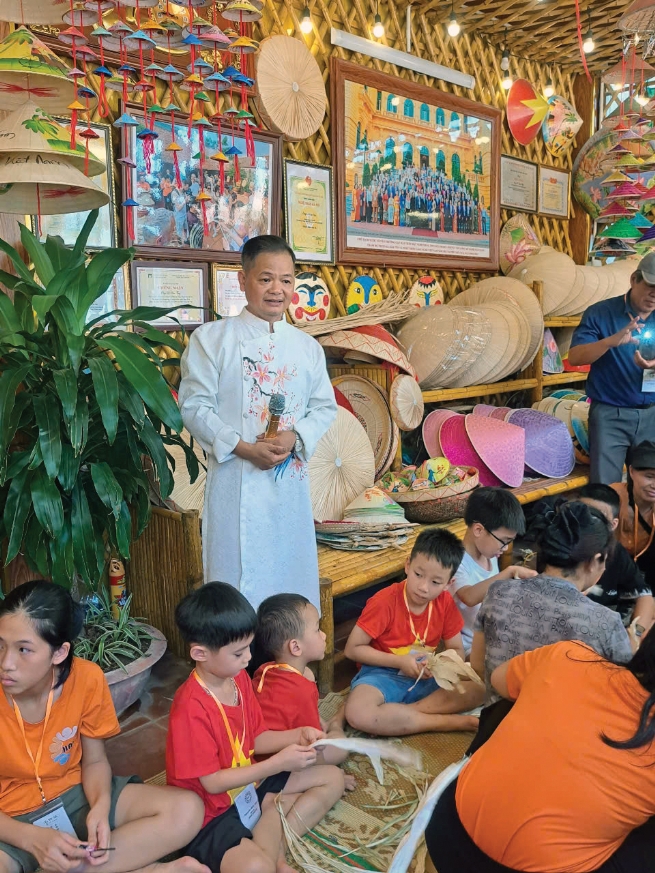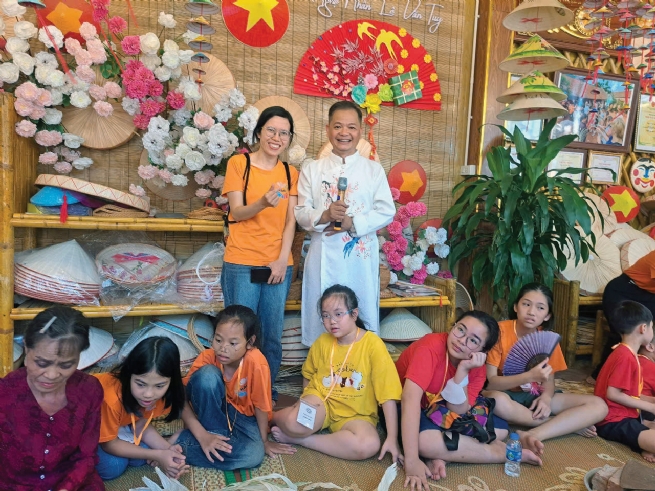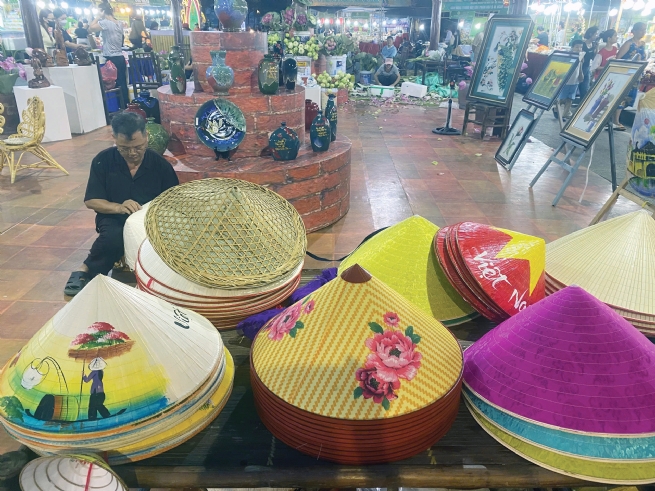3:24:29 PM | 6/19/2025
Chuong village in Thanh Oai district, Hanoi, is renowned across the country for its long-standing craft of making conical leaf hats, a symbol of the Vietnamese soul. In the face of modern challenges, Chuong Village hats have evolved from simple protection against rain and sun to handicraft products carrying high cultural and artistic value.


Children show keen interest in learning to make traditional hats
In particular, the hats made by artisan Le Van Tuy, who has been involved in the profession for more than 50 years, have affirmed the special position of of Chuong Village hats on Hanoi’s One Commune One Product (OCOP) product map.
Chuong village has long been known as one of the cradles of the hat-making profession in the North. The hats here possess a graceful and delicate beauty, from the needlework to each layer of meticulously processed palm leaves. Choosing the right leaves is an important step – only palm leaves that are picked at the right time, dried in the sun, and carefully incubated are qualified to make conical hats. The leaves are scrubbed clean, softened, then flattened before being layered and meticulously sewn by hand onto a round bamboo frame.
The traditional conical hats have long been associated with the gentle, hard-working image of Vietnamese women. Not only appearing in daily life, they also accompany artists, models, and art troupes as they represent Vietnamese culture to international friends at cultural, fashion, and handicraft exhibitions.


Chuong’s conical leaf hats embody high cultural and artistic value
A lifetime devoted to craftsmanship and cultural pride
Born and raised in a family with a long-standing hat-making tradition in Chuong village, artisan Le Van Tuy was exposed to the craft early on and learned it from his father. For him, making conical hats is not only a way of life but also a passion – the greatest passion of his life.
Sharing about his career journey, artisan Le Van Tuy proudly said: “The family’s hat products have won five 4-star OCOP awards, among which the monk’s hat received awards from both Hanoi and the Ministry of Agriculture and Environment after three years.”
The “monk’s hat” – a unique product imbued with tradition and meditation – is a creation by him and his family. The hat has a special shape, designed based on the actual needs of monks and Buddhists, combining both aesthetics and functionality for religious life. This is one of the outstanding products that has contributed to bringing the name of his hat workshop closer to a wide range of domestic and international consumers.
Currently, artisan Le Van Tuy’s workshop employs more than 20 workers, producing around 1,000 products for the market each day. All items are crafted from natural materials such as palm leaves, bamboo, and nylon thread, with a focus on environmental friendliness.
“The family has also received a lot of support from local authorities, as well as central agencies. Hanoi Coordination Office of the New Rural Development Program has supported our booth many times to participate in programs, fairs, and product promotion weeks,” said Tuy.
Thanks to the support from local authorities, the hat workshop now not only sells at the market or to wholesalers, but also has the opportunity to display products at major fairs, trade promotion events, and especially a booth located right in the courtyard of Chuong village’s communal house, welcoming domestic and international visitors. This is not only a commercial activity but also a way to convey Vietnamese culture to friends around the world.
Balancing tradition with innovation and sustainability
However, in the era of industrialization, handmade hats face intense competition from plastic and fabric hats. These industrial products are cheap and easy to mass-produce, but they pose many potential risks to both the environment and consumer health.
“Due to competition from other products on the market such as plastic hats, our hats are harder to sell than before. Plastic products are harmful to the environment and inconvenient for long-term use, affecting users’ health. But because they are inexpensive, some customers still opt for them,” Tuy shared with concern.
Despite this, he and his family persist in their craft, viewing it as a mission to preserve traditional values, rather than a mere business. With 50 years of experience, he has built a strong reputation and a loyal customer base, including many international customers who are interested in sustainable, handmade products.
A highlight of his workshop is its spirit of innovation. The hats are not mass-produced or stereotypical; each model is designed by the family, from style and color to decorative motifs. This creativity not only diversifies the products to meet different market demands, but also expresses the unique identity and personal touch of the artisan.
He said that all the hat designs were created by their family, and that they not only made hats for wearing but also created decorative hats, art hats, and hats for cultural and fashion performances.
It is this combination of tradition and innovation that helps his hat products evolve and be warmly received by customers.
In the context of rural economic development associated with cultural preservation, artisan Le Van Tuy’s hat production model is a shining example. Not stopping at production, he also participates in vocational training for the younger generation and teaches fellow villagers, creating stable jobs for dozens of local workers.
With passion, creativity, and timely support from the government, Chuong village hats, especially those made by artisan Le Van Tuy, have reached further and contributed to preserving and promoting the heritage value of Vietnamese craft villages in the new era.
From the simple conical hat to a symbol of Vietnamese culture, the 50-year journey of artisan Le Van Tuy is living proof of love, commitment, and responsibility for traditional crafts. The hats created by his talented hands not only protect wearers from the sun and rain but also carry deep passion, cultural essence, and national pride.
By Bui Lien, Vietnam Business Forum
| This special section is supported by Hanoi Coordination Office of the New Rural Development Program |